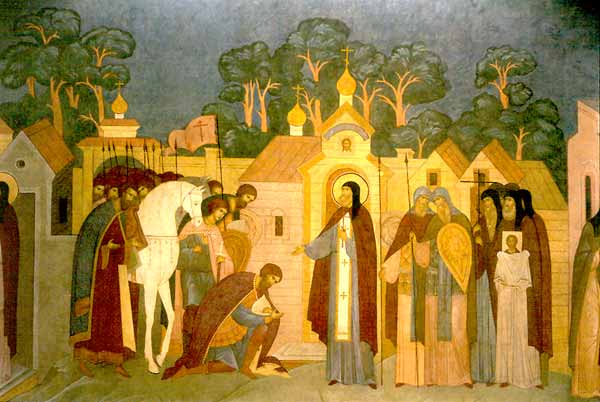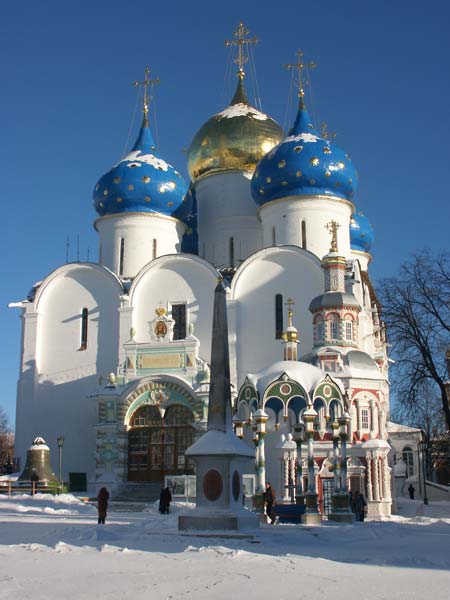The Holy Trinity-St. Sergius Lavra (3)
22 Μαρτίου 2009
In 1380, Prince Dimitry Donskoy of Moscow came to seek St. Sergius` blessing before leading his army for the Orthodox faith and for the liberation of his native land from the Mongol yoke, which greatly oppressed Russia since 1237. Having received the saint’s blessing to go against the godless enemies, the Grand Prince won a great victory over the army of the Tartar Khan Mamai on the Kulikovo Field on the 8th of September. It was the first major Russian victory against the Tartars. After that, Moscow Princes became the patrons of the Trinity monastery.St. Sergius entrusted his holy and pure soul to God on September 25, 1392. His successor as abbot of the Trinity monastery was St. Nikon, first among his disciples.
St. Nikon (1355-1426) was from the city of Yuriev-Polsky (half way between Rostov and Radonezh). He came to the Trinity monastery at a very early age, that’s why St. Sergius put him under the guidance of his disciple St. Athanasius, the abbot of the Theotokos on the Mountain monastery in Serpukhov. In 1375 St. Nikon returned to the Trinity monastery and became St. Sergius` closest co-worker. Half a year before his death, St. Sergius entrusted the leadership of the monastery to St. Nikon and vowed himself to silence. He was abbot of the monastery until his death in 1426. St. Nikon rebuilt the entire monastery that had been destroyed during the invasion by Khan Edigei in 1408. In 1422 the holy relics of St. Sergius were discovered during the construction of the Trinity Cathedral. St. Nikon commissioned the famous iconographers Andrei Rublev and Daniel the Black to paint the cathedral. The work was finished by 1425.
St. Nikon died in 1426 and was buried by the southern wall of the Trinity Cathedral, where a church dedicated to him was constructed in 1548, a year after his canonization. The church was rebuilt in 1623. At the western wall of it there is a chapel called Serapion’s Tent, constructed above the tomb of St. Serapion, archbishop of Novgorod.
In the reign of the tsar Ivan IV, who had a particular veneration for St. Sergius, the monastery was surrounded by a stone enclosure topped by 12 towers. After the end of the wars against Tartars and the victory over the kingdoms of Kazan and Astrakhan , the tsar began building a large and beautiful church, dedcated to the Dormition of the Mother of God, a copy of the Kremlin Dormition Cathedral. The walls, the pillars and the vaults are covered with frescoes on the subjects of Church History. Most of the wall frescoes are dedicated to the Dormition of the Holy Virgin. On the pillars there are images of the most highly venerated saints of the Orthodox Church. The magnificent frescoes of the Cathedral were created in 1684 by 35 painters in a 100 days. The frescoes cover the area of 500 square metres. The 5-tier iconostasis consists of 76 icons dated back to the 16th-17th centuries. The celebrated seventeenth-century painter Simon Ushakov, the royal isographer, took part in the creation of the iconostasis.In the Dormition Cathedral there are two shrines with the holy relics of St. Filaret (Drozdov † 1867) and St. Innokenty (Veniaminov † 1879), Metropolitans of Moscow. By the western wall, to the right of the entrance, you can see the tomb of Makarius (Bulgakov † 1882), one of Moscow Metropolitans, who created many outstanding works on the history of the Russian Orthodox Church and on dogmatic theology.





